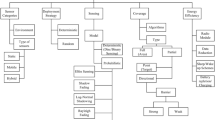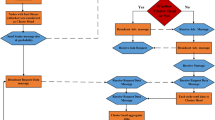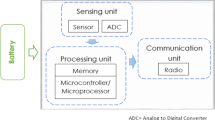Abstract
Quality of coverage is one of the fundamental issues in wireless sensor networks, particularly for the deterministic placement of sensors. One of the methods to improve the quality of coverage is to place the minimum number of sensors in the optimal position to cover the entire target. This paper proposes a discrete Haar wavelet transform for deterministic sensor placement in the target coverage problem. Dilation and translation of Haar wavelet transform are used for identifying the optimal position of sensors. Simulation results validate the performance of discrete Haar wavelet transform better than random placement in terms of optimal placement, quality of coverage and network traffic reduction.








Similar content being viewed by others
References
Akyildiz, I. F., Su, W., Sankarasubramaniam, Y., & Cayirci, E. (2002). Wireless sensor networks: A survey. Computer Networks, 38, 393–422.
Singh, D. P., Bhateja, V., & Soni, S. K. (2013). An efficient cluster-based routing protocol for WSNs using time series prediction-based data reduction scheme. International Journal of Measurement Technologies and Instrumentation Engineering, 3(3), 18–34.
Singh, D. P., Bhateja, V. Soni, S. K. & Shukla, A. K. (2014). A novel cluster head selection and routing scheme for wireless sensor networks. In Advances in signal processing and intelligent recognition systems (pp. 403–415).
Younis, Mohamad, & Akkaya, Kemal. (2008). Strategies and techniques for node placement in wireless sensor networks: A survey. Ad Hoc Networks, 6, 621–655.
Arivudainambi, D., & Balaji, S. (2016). Improved memetic algorithm for energy efficient sensor scheduling with adjustable sensing range. Wireless Personal Communication. https://doi.org/10.1007/s11277-016-3883-7.
Mini, S., Udgata, Siba K., & Sabat, Samrat L. (2014). Sensor deployment and scheduling for target coverage problem in wireless sensor networks. IEEE Sensors Journal, 14(3), 636–644.
Sangwan, A., & Singh, R. P. (2014). Survey on coverage problems in wireless sensor networks. Wireless Personal Communication, 80, 1475–1500.
Chui, C. (Ed.). (1992). Wavelets: A tutorial in theory and applications. Cambridge: Academic Press.
Daubechies, I. (1992). Ten lectures on wavelets, Society for Industrial and Applied Mathematics.
Boukerche, A., & Fei, X. (2007). A coverage-preserving scheme for wireless sensor network with irregular sensing range. Ad Hoc Networks, 5, 1303–1316.
Huang, C.-F., & Tseng, Y.-C. (2003). The coverage problem in a wireless sensor network. In Second ACM international conference on wireless sensor networks and applications (pp. 115–121).
Pompili, D., Melodia, T. & Akyildiz I. F. (2006). Deployment analysis in underwater acoustic wireless sensor networks. In ACM international workshop on under water networks (pp. 48–55).
Unaldi, N., Temel, S., & Asari, Vijayan K. (2012). Method for optimal sensor deployment on 3D terrains utilizing a steady state genetic algorithm with a guided walk mutation operator based on the wavelet transform. Sensors, 12, 5116–5133.
Dhillon, S. S., Chakrabarty, Krishnendu, & Iyengar, S. S. (2002). Sensor placement for grid coverage under imprecise detections. Fifth International Conference on Information Fusion, 2, 1581–1587.
Dhillon S. S. & Chakrabarty, K.. (2003). Sensor placement for effective coverage and surveillance in distributed sensor networks. In IEEE International conference on wireless communications and networking, pp. 1609–1614.
Temel, S., Unaldi, N., & Kaynak, Okyay. (2014). On deployment of wireless sensors on 3-D terrains to maximize sensing coverage by utilizing cat swarm optimization with wavelet transform. IEEE Transactions on Systems, Man, and Cybernetics: Systems, 44(1), 111–120.
Ranieri, J., Chebira, A., & Vetterli, M. (2014). Near-optimal sensor placement for linear inverse problems. IEEE Transactions on Signal Processing, 62(5), 1135–1146.
Arivudainambi, D., Balaji, S. & Rekha, D. (2014). Improved memetic algorithm for energy efficient target coverage in wireless sensor networks. In The eleventh IEEE international conference on networking, sensing and control (pp. 261–266).
Arivudainambi, D., Sreekanth, G., & Balaji, S. (2016). Energy efficient sensor scheduling for target coverage in wireless sensor network. Wireless Communications, Networking and Applications, Lecture Notes in Electrical Engineering, 348, 693–705.
Mostafaei, H., & Meybodi, M. R. (2013). Maximizing lifetime of target coverage in wireless sensor networks using learning automata. Wireless Personal Communications, 71(2), 1461–1477.
Cardei, Mihaela, & Ding-Zhu, Du. (2005). Improving wireless sensor network lifetime through power aware organization. Wireless Networks, 11(3), 333–340.
Slijepcevic, S., & Potkonjak, M. (2001). Power efficient organization of wireless sensor networks. IEEE International Conference on Wireless Communications, 2, 472–476.
Sun, S., Sun, Li, & Chen, Shu. (2016). Research on the target coverage algorithms for 3D curved surface. Chaos, Solitons & Fractals, 89, 397–404.
Meyer, Y. (1993). Wavelets: algorithms and applications. Society for Industrial and Applied mathematics.
Mallat, S. (1988). A wavelet tour of signal processing. Cambridge: Academic Press.
Shahabi, C., Chung, S., Safar, M. & Hajj, G. (2001). 2D TSA—tree: A wavelet—based approach to improve the efficiency of multi-level spatial data mining. In Thirteenth international conference on scientific and statistical database management (pp. 59–68).
David, F. (2002). An introduction to wavelet analysis. Basel: Birkhauser.
Shahabi, C., Tian, X. & Zhao, W. (2000). TSA-tree: A wavelet—based approach to improve the efficiency of multi-level surprise and trend queries on time series data. In International conference on scientific and statistical database management (pp 55–68).
Prabhakaran, S., Sahu, R., & Verma, S. (2007). Classification of multi class dataset using wavelet power spectrum. Data Mining and Knowledge Discovery, 15(3), 297–319.
Radunavic, D. P. (2009). Wavelets from math to practice. Berlin: Springer.
Acknowledgements
One of the authors S. Balaji gratefully acknowledges the financial support received from Anna University under Anna Centenary Research Fellowship to carry out this research work.
Author information
Authors and Affiliations
Corresponding author
Additional information
Publisher's Note
Springer Nature remains neutral with regard to jurisdictional claims in published maps and institutional affiliations.
Rights and permissions
About this article
Cite this article
Arivudainambi, D., Balaji, S., Sripathy, B. et al. Enhancing Quality of Coverage for Target Coverage Problem Using Discrete Haar Wavelet. Wireless Pers Commun 101, 1817–1837 (2018). https://doi.org/10.1007/s11277-018-5792-4
Published:
Issue Date:
DOI: https://doi.org/10.1007/s11277-018-5792-4




